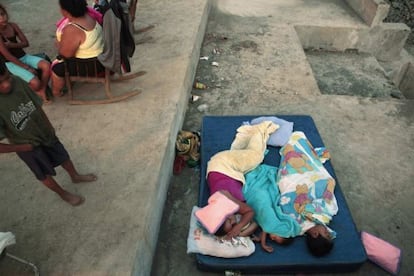Calm returns to Nicaragua after a chain of strong earthquakes rocks capital
A team of international experts in Managua wants to determine what sparked the tremors


Calm returned to Nicaragua on Tuesday after the entire nation was put on alert following a series of strong earthquakes that rocked the capital and the surrounding central regions for four days.
At least two deaths and 42 injuries were reported in the province after four earthquakes – one measuring 6.2 on the Richter scale – and about 1,000 strong aftershocks that began on Thursday sent thousands of Managua residents fleeing from their homes.
Nicaraguan civil defense authorities counted 2,378 homes damaged during the disaster.
The government issued an emergency alert on Sunday after scientists reported unusual seismic activity where the Coco and Caribbean crustal plates join underneath Nicaragua’s surface. In 1972, more than 10,000 people were killed and 20,000 others injured when a strong earthquake devastated Managua. The quake was blamed on the crustal plates’ movements.
Television stations on Tuesday showed dozens of Managua residents returning to their homes and clearing up after the damage. The entire capital was empty as businesses were closed and many workers decided to take advantage of the government’s emergency alert and push up their long Easter weekend holiday.
Trying not to instill panic, government officials had warned people to remain outdoors and not to sleep inside their homes.
Government officials had warned people to remain outdoors and not to sleep inside their homes
“At the entrance to my home, I have a backpack filled with clothes and other things waiting. The tank in my car is full. We’re not panicky, just nervous,” said Juan, a lawyer, after he filled up at a gas station in Managua.
In the few supermarkets that were open, shoppers were stocking up on basic essentials.
The government set up temporary shelters throughout the capital and in nearby cities where more than 1,600 sought refuge, according to first lady Rosario Murillo, who also serves as her husband’s official spokesman.
President Daniel Ortega did not appear in public during the emergency, setting off waves of criticism from the opposition. “The country is being run by a ventriloquist,” wrote noted journalist Carlos Fernando Chamarro on his Twitter account. “Why is he so quiet?”
The Sandinista government said that it welcomes a team of experts from Germany, Cuba, the United States, Japan, Mexico and Venezuela to determine the exact causes of the seismic activity.
US missionary’s body found
The body of a 37-year-old missionary from the United States was found on a beach in Nicaragua’s Pacific coast, authorities said on Wednesday.
Karen Colclough, who was reported missing on Friday, was apparently abused before she was strangled, the Managua daily El Nuevo Diario reported, quoting a source close to the investigation.
Her body was found dumped on the beach near the community of Montelimar, San Rafael del Sur municipality, in Managua department, according to the US Embassy in Managua.
Authorities have no clues surrounding her death.
Colclough was a member of the Presbyterian Church of Jackson Hole, Wyoming and had come to Nicaragua as part of a religious mission.
"We are asking people to keep the family in prayer — mother, father, brother," Rev. Paul Hayden of the church told the Jackson Hole News & Guide daily. "This is going to be a very difficult time."
Tu suscripción se está usando en otro dispositivo
¿Quieres añadir otro usuario a tu suscripción?
Si continúas leyendo en este dispositivo, no se podrá leer en el otro.
FlechaTu suscripción se está usando en otro dispositivo y solo puedes acceder a EL PAÍS desde un dispositivo a la vez.
Si quieres compartir tu cuenta, cambia tu suscripción a la modalidad Premium, así podrás añadir otro usuario. Cada uno accederá con su propia cuenta de email, lo que os permitirá personalizar vuestra experiencia en EL PAÍS.
¿Tienes una suscripción de empresa? Accede aquí para contratar más cuentas.
En el caso de no saber quién está usando tu cuenta, te recomendamos cambiar tu contraseña aquí.
Si decides continuar compartiendo tu cuenta, este mensaje se mostrará en tu dispositivo y en el de la otra persona que está usando tu cuenta de forma indefinida, afectando a tu experiencia de lectura. Puedes consultar aquí los términos y condiciones de la suscripción digital.
Últimas noticias
From digital curfews to blocking apps: How technology experts protect their children online
Why the price of coffee has skyrocketed: from Brazilian plantations to specialty coffee houses
Confined to a Cuban hospital: When electricity is a matter of life or death
The complicated life of Francesca Albanese: A rising figure in Italy but barred from every bank by Trump’s sanctions
Most viewed
- Why we lost the habit of sleeping in two segments and how that changed our sense of time
- Pablo Escobar’s hippos: A serious environmental problem, 40 years on
- Trump’s obsession with putting his name on everything is unprecedented in the United States
- The Florida Keys tourist paradise is besieged by immigration agents: ‘We’ve never seen anything like this’
- Charles Dubouloz, mountaineering star, retires at 36 with a farewell tour inspired by Walter Bonatti








































